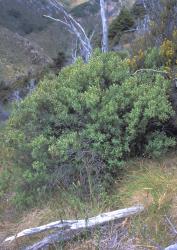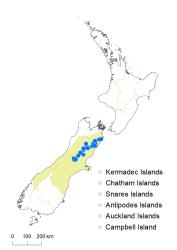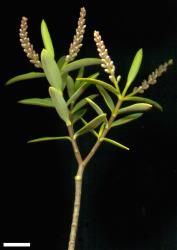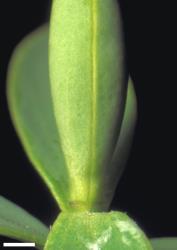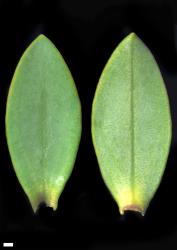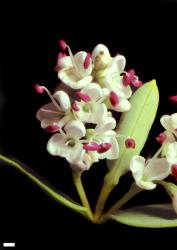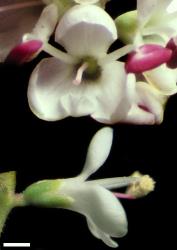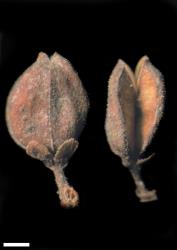- ≡ Hebe glaucophylla (Cockayne) Cockayne, Trans. New Zealand Inst. 60: 471 (1929)
- = Veronica traversii var. fallax Cheeseman, Man. New Zealand Fl. 519 (1906)
Shrub to 2 m tall. Stems erect, eglandular-puberulent; hairs bifarious or uniform. Leaf bud distinct, its leaves appressed at margins until fully grown; sinus absent. Leaves opposite-decussate, erecto-patent to spreading, becoming recurved; lamina coriaceous, lanceolate to elliptic or oblong, 7–25 mm long, 4–8 mm wide, dull glaucous above and beneath; midrib and often two lateral veins evident; surfaces glabrous, or eglandular hairs along midrib above, especially near base; margin usually glabrous and minutely papillate, rarely with very minute, forwardly directed hairs, entire; apex sub-acute to acuminate; base cuneate; petiole indistinct, 0–1 mm long. Inflorescence a lateral raceme, 13–46 mm long; flowers crowded, 15–31, all bisexual; bracts alternate or often the lowermost opposite, deltoid to broadly elliptical, rarely narrower, ≤ pedicels; pedicels erecto-patent, 0.5–3.0 mm long, puberulent all round. Calyx lobes 4, rarely 5 (5th lobe small, posterior), rounded, obtuse, or sometimes sub-acute, 1.5–2.0 mm long, sub-equal, mixed eglandular- and glandular-ciliolate, or rarely eglandular-ciliolate. Corolla 5–6 mm diameter; tube white, 1.0–2.3 mm long, usually < calyx, sometimes > calyx, eglandular-hairy inside; lobes 4, white, erecto-patent to spreading, unequal, broadly elliptic to obovoid or rhomboid, 2.5–3.5 mm long, rounded; nectar guides absent. Stamen filaments white, 3.0–4.6 mm long; anthers magenta, pink, or yellowish. Style eglandular-hairy or sometimes glabrous, 3.0–5.3 mm long. Capsules latiseptate, sub-acute to obtuse, eglandular-puberulent or sometimes glabrous with age, 2.5–4.0 mm long, 1.9–3.1 mm at widest point. Seeds ellipsoid, flattened, smooth, brown, 1.6–2.2 mm long.
The very short, puberulent indumentum on the stems, inflorescences, and capsules, the pedicels usually > bracts, and the usually very short corolla tube distinguish plants of V. glaucophylla from many other hebes that also have glaucous leaves and no sinus in the leaf bud. V. topiaria plants are similar but have quite long hairs on the stems.
South Island: Marlborough, Canterbury (inland from Lake Tennyson and mountains near Hanmer Springs to the Craigieburn Range, especially near Castle Hill Basin), Westland (near the Main Divide in the far north-west).
Montane, or occasionally lowland, scrub, often on rock outcrops. Recorded elevations range from 250 to 1219 m.
Flowers: December–March; fruits: January–May, persisting until December.
2n = 80 (see Bayly & Kellow 2006, as Hebe glaucophylla).
Veronica glaucophylla is classified in V. subg. Pseudoveronica sect. Hebe and the informal group “Occlusae” (Albach & Meudt 2010; Bayly & Kellow 2006).
It is not certain that all populations of V. glaucophylla are cosexual, and there may be male-sterile plants in some populations (Bayly & Kellow 2006).



